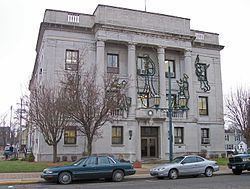Area 1,098 km² Population 28,665 (2013) | Congressional district 15th Website www.co.hocking.oh.us Founded 1818 | |
 | ||
Points of interest Hocking Hills State Park, Conkle's Hollow State Nat, Hocking Hills Canopy T, Lake Logan State Park, Rose Lake Destinations Hocking Hills State Park, Logan, Hocking Hills, Rockbridge, Ash Cave | ||
Hocking County is a county located in the U.S. state of Ohio. As of the 2010 census, the population was 29,380. Its county seat is Logan. The county was organized on March 1, 1818, from land given by Athens, Fairfield, and Ross counties. Its name is from the Hocking River, the origins of which are disputed but is said to be a Delaware Indian word meaning "bottle river".
Contents
- Map of Hocking County OH USA
- Geography
- Waterways
- Adjacent counties
- National protected area
- 2000 census
- 2010 census
- Government
- City
- Villages
- Census designated places
- Unincorporated communities
- References
Map of Hocking County, OH, USA
Hocking County is included in the Columbus, OH Metropolitan Statistical Area.
Geography
According to the U.S. Census Bureau, the county has a total area of 424 square miles (1,100 km2), of which 421 square miles (1,090 km2) is land and 2.3 square miles (6.0 km2) (0.5%) is water.
Waterways
The major waterway of Hocking County is the Hocking River, which flows roughly from WNW to ESE, arising in Fairfield County and flowing from Hocking County into Athens County. This river drains about half the county. To the southwest, much of the rest of the county is drained by Salt Creek, which flows from there into Vinton County. A small part of the southeastern county is drained by Raccoon Creek, which also flows into Vinton County. The easternmost area of the county is within the Monday Creek watershed. A small area in the north of the county is drained by Rush Creek.
Adjacent counties
National protected area
2000 census
As of the census of 2000, there were 28,241 people, 10,843 households, and 7,828 families residing in the county. The population density was 67 people per square mile (26/km²). There were 12,141 housing units at an average density of 29 per square mile (11/km²). The racial makeup of the county was 97.54% White, 0.92% Black or African American, 0.29% Native American, 0.08% Asian, 0.08% from other races, and 1.09% from two or more races. 0.44% of the population were Hispanic or Latino of any race.
There were 10,843 households out of which 33.50% had children under the age of 18 living with them, 58.30% were married couples living together, 9.50% had a female householder with no husband present, and 27.80% were non-families. 23.70% of all households were made up of individuals and 10.00% had someone living alone who was 65 years of age or older. The average household size was 2.54 and the average family size was 2.98.
In the county, the population was spread out with 25.50% under the age of 18, 8.10% from 18 to 24, 28.30% from 25 to 44, 25.00% from 45 to 64, and 13.10% who were 65 years of age or older. The median age was 38 years. For every 100 females there were 99.30 males. For every 100 females age 18 and over, there were 97.90 males.
The median income for a household in the county was $34,261, and the median income for a family was $40,888. Males had a median income of $31,951 versus $24,123 for females. The per capita income for the county was $16,095. About 10.30% of families and 13.50% of the population were below the poverty line, including 15.80% of those under age 18 and 14.50% of those age 65 or over.
2010 census
As of the 2010 United States Census, there were 29,380 people, 11,369 households, and 7,948 families residing in the county. The population density was 69.7 inhabitants per square mile (26.9/km2). There were 13,417 housing units at an average density of 31.8 per square mile (12.3/km2). The racial makeup of the county was 97.5% white, 0.7% black or African American, 0.3% American Indian, 0.2% Asian, 0.2% from other races, and 1.1% from two or more races. Those of Hispanic or Latino origin made up 0.7% of the population. In terms of ancestry, 25.3% were German, 15.0% were American, 14.1% were Irish, and 9.0% were English.
Of the 11,369 households, 32.3% had children under the age of 18 living with them, 53.9% were married couples living together, 10.7% had a female householder with no husband present, 30.1% were non-families, and 24.8% of all households were made up of individuals. The average household size was 2.52 and the average family size was 2.98. The median age was 40.9 years.
The median income for a household in the county was $39,586 and the median income for a family was $48,796. Males had a median income of $39,219 versus $30,371 for females. The per capita income for the county was $19,048. About 12.3% of families and 15.3% of the population were below the poverty line, including 20.7% of those under age 18 and 10.8% of those age 65 or over.
Government
The county commissioners are Sandra Ogle, Gary Waugh, and Jeff Dickerson, and the Hocking County Sheriff is Lanny North.
